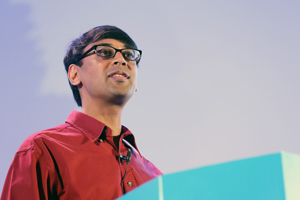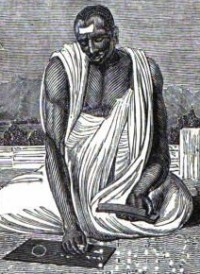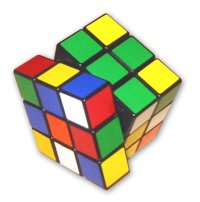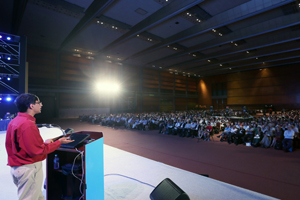
Numbers, toys and music: A conversation with Manjul Bhargava
Manjul Bhargava won a Fields Medal, one of the highest honours in maths, at this year's International Congress of Mathematicians (ICM) in Seoul. This is a transcript of our interview with him. You can also listen to it as a podcast, read an abridged version of the lecture he gave at the ICM, or find out more about his work in this Plus article.

Manjul Bhargava (centre) with Plus editors Rachel and Marianne
Plus: Manjul, congratulations on your win! You are now officially one of our favourite speakers at the ICM. It was unbelievable how accessible your talk was to non-specialists like ourselves. We understand that people in the field, number theorists, were equally getting a lot out of your talk. Is public understanding of mathematics, popularisation of mathematics, is that something you're involved with yourself?
Manjul: Thank you for saying that, yes very much so. I think one of the really important jobs of mathematicians is not just to do their research work, but also to reach out and explain their work to the community outside mathematics. I think that's a very important job of mathematicians; we don't always do it enough. In the past few years I have been making an effort to reach out as well, and explain some of the beautiful things that are happening in mathematics to outside the mathematics community.
Plus: Do you think that perhaps the area of number theory particularly lends itself to popularisation? Because there are some results that even though they're very, very difficult to prove, they can be explained without too much technical knowledge. We are in the process of writing an article based on your talk, because it was so accessible. Do you think that number theory is good for that?
Manjul: Yes, number theory is a great area for that, because a lot of the very fundamental problems go back thousands of years, before all this mathematical machinery and jargon developed. The basic problems of number theory have remained the same for thousands of years, they have been very similar, they're very simply state-able, and that's something that's very attractive about number theory.
The methods to solve some of these problems are extremely deep, but the problems that you are eventually trying to solve are very concrete, very, very accessible.
Everything except 15
Plus: Could you give an example of a result that has been around for a long time that has just recently been solved, and that you could state quite easily?
Manjul: I'll give an example that's not from my lecture. It is the question of when a mathematical expression takes every possible value. There [is a] famous result from the 1700s of Lagrange, which says that every whole number can be expressed as the sum of four squares. So for example; 19 = 16 + 1 + 1 + 1 = 42 + 12 + 12 + 12.
This result is surprising to many people when you tell them the first time because the squares get further and further apart as you go up: 1, 4, 9, 16, 25, etc. Yet no matter how big a number you take, you can always express it as the sum of four square numbers. This is the result from the 1700s of the mathematician Lagrange.

Srinivasa Ramanujan was a self-taught Indian mathematician who made significant contributions to number theory.
There was not much further progress beyond this question until some work of Ramanujan around 1910. Another way to say Lagrange's theorem is that the expression a2 + b2 + c2 + d2 represents every whole number. Every [positive] whole number can be expressed as a2 + b2 + c2 + d2 [where a, b, c, and d are whole numbers]. What other quadratic expressions like that have the same property that every possible positive whole number value is taken?
[Ramanujan] wrote down 54 more examples of such expressions, so in addition to a2 + b2 + c2 + d2, he also had a2 + b2 + c2 + 2d2. In other words every number is also the sum of three squares plus twice a square. He also said every number is the sum of three squares plus three times a square. Every number is also the sum of three squares plus four times a square; there are also additional expressions that take every possible integer value. All the way up to a2 + b2 + c2 + 7d2, that also takes every positive integer value. On his list there wasn't a2 + b2 + c2 + 8d2. That's not there because 7 cannot be expressed in that form.
Plus: Is it true that on [Ramanujan's] initial list there was one expression that leaves out just the number 15? [So he was wrong in including it as it does not yield all positive whole numbers?]
Manjul: That's right yes.
Plus: So one expression that can express all integers, all whole numbers except 15. That's quite funny that Ramanujan didn't spot that.
Manjul: Yes, that particular quadratic form is what caused the breakthrough. Even his mistakes sometimes were inspirational because they were mistakes for a very special reason. That quadratic form that he had on his list was a2 + 2b2 + 5c2 + 5d2; it turns out every number can be written like that except for 15.
That led, in the 1990s to John Conway proving what is called the 15 theorem. He and his student William Schneeberger proved the theorem, which [concerned] quadratic expressions like this in any number of variables, but where you also allow cross terms like 2bc or 2ad, only those cross terms should have even coefficients. This will allow things like a2 + 2bd + b2 + 3c2 + 4d2.
What [Conway] and Schneeberger showed is that if [and only if] such a quadratic expression takes the values 1 through 15 then it takes all positive integer values. Fifteen turned out to be so key in this whole theory that the reason you need 15 is illustrated by Ramanujan's "mistake". It turns out that that particular quadratic form that he wrote down was the very key in making further progress on this problem.
Everything up to 290

Manjul Bhargava talking about his work at the ICM 2014. Copyright ⓒ 2010-2014 International Congress of Mathematicians 2014, all rights reserved.
Manjul: [But] remember this 15 theorem of Conway and Schneeberger was for restricted quadratic forms where those cross terms are only allowed to have even coefficients. If you want to allow general quadratic expressions with whole number coefficients is there a similar statement? Conway and his students conjectured that you probably need to go up to the number 290 in that case. That was their 290 conjecture — the 290 conjecture is that if you have a quadratic expression that only takes positive values, then it takes all positive integer values if and only if it takes the [values] 1 through 290.
Plus: It's probably one of the few places the number 290 plays such an important role.
Manjul: So that [the 290 conjecture] was proven in my recent work with Jonathan Hanke, he and I proved this. We were graduate students together and good friends in graduate school, and after graduate school we thought, "Let's try to prove this." That was a really fun project to work on.
Plus: Didn't you reduce the set as well so that you didn't need to check through all numbers?
Manjul: Yes, you don't need to check through everything between 1 and 290; you only need to check a certain set of 29 numbers in that range of 1 through 290. If those 29 numbers are there as values then all integers are there as values, that's the 290 theorem. We call it the 290 theorem now. [See here for a list of the 29 numbers.]
Plus: So is the 290 theorem depending on 29 numbers? Is that coincidental or is there some reason, that it's a factor of 10...?
Manjul: I think it's coincidental, we don't see the reason.
Plus: The fact that it's those particular numbers that you need to check, does that tell you something about the structure of the positive integers? Is there something about those numbers that's significant?
Manjul: I don't know that I can say too much about that other than for each one of those 29 numbers we can write down a quadratic expression that takes every value except that number. So you definitely need those numbers and you don't need anything else with the 290 theorem.
The proof of that was very fun in that it requires both theoretical mathematics in a very serious way and also computational mathematics. So that required a lot of programming and new algorithms that are only [newly] available — it's kind of interesting, on the theoretical side, the things we used are techniques for mathematics that have only arisen very recently. The same on the computational side, all the techniques that we needed have only just recently arisen and we were able to combine all of them, both the pure and the computational, to prove these results.
Inspiration from Sanskrit
Plus: When you were younger you read [the famous eighteenth century mathematician] Gauss' work and actually began to work on problems from that. How old were you when you were reading that, and what was it about it that caught your interest?

An artist's impression of the seventh century mathematician and astronomer Brahmagupta.
Manjul: I started reading Gauss when I was in graduate school actually. There are some things that I read before Gauss that got me interested in Gauss. It turns out my grandfather is a scholar of Sanskrit, so I learned a lot of Sanskrit growing up. I was introduced to the work of [the seventh century Indian mathematician] Brahmagupta when I was young. One thing that really inspired me at that time was the following theorem – instead of looking at numbers that are the sum of four squares, let's look at numbers that are the sum of two squares. Not every number is the sum of two squares. Five is [because 5 = 12 + 22] but 7 is not, and 6 is not.
What can we say about the subset of numbers that are the sum of two squares? One ancient theorem that I saw in Brahmagupta's work is that if you take the product of two such numbers that are each the sum of two squares, then the product is again the sum of two squares. Mathematicians would say this set is closed under multiplication. There is a generalisation of this result in there, namely that if you take a number that's the sum of a square and then n times a square and you multiply it with another such number (that's a square plus n times a square) then it will again be a number that's a square plus n times a square.
[Phrased in mathematical language this means that if a, b, c and d are whole numbers and n is also a whole number, then the product
(a2 + nb2) x (c2 + nd2)
is also of the form e2 x nf2 where e and f are whole numbers.]Manjul: For any value of n this is true. That's something I read in Brahmagupta. It dates back to about the year 600, and is written in Sanskrit.
Plus: Did you read it in the Sanskrit?
Manjul: Yes. I had the Sanskrit version and the translation, this was one way that I was learning a little bit about Sanskrit. I loved that fact, I thought it was really cool that it's always true. It has a really nice explanation in terms of the complex numbers and so that got me excited about the complex numbers. So that was something that came up in my childhood, and then in graduate school I learned that there was a vast generalisation of this, of Gauss. So I guess that was about 1200 years later after Brahmagupta, there was a lot of stuff that happened after that result of Brahmagupta, which is called Brahmagupta's identity.
There was a lot of work in between and it culminated in Gauss. What Gauss showed was how to decide when you can have the following statement: if a number is represented by a certain quadratic expression and you multiply it by a number represented by a second quadratic expression, when can you always say that the resulting product will be always represented by a certain third quadratic expression? Gauss classified all such triples of quadratic expressions for which you can say that; that's called the Gauss composition. If you could make that statement for some set of three quadratic expressions, then you say that the product of the first two quadratic expressions is the third under a Gauss composition, that's what Gauss composition is.
So I read that as a graduate student, and I was amazed by it of course. It's something that takes Gauss something like twenty pages to prove.
Rubik eureka
Plus: Then you discovered a new way of looking at it using Rubik's cube?
Manjul: Yes.
Plus: So how did that happen? It was at midnight wasn't it?

Inspiration from a Rubik's cube.
Manjul: Yes, I still remember that and I tell people that often. I was in my dorm room getting ready to go to bed, I had these Rubik's cubes in my room and I was just looking at one. I just have this memory of thinking, "What happens if you put numbers on the corners of this Rubik's cube? Instead of just thinking of it as a simple cube, think of it with numbers on the corners". I put numbers on the corners of that cube and I did some manipulations, and I saw three quadratic forms coming out, three quadratic expressions coming out. I decided not to go to sleep, that I'd figure out what these three quadratic expressions [were], how were they related.
It turns out that their product is trivial in this Gauss composition law, in other words, it gave a very symmetric way of viewing Gauss' composition in a very simple few lines, instead of the difficult mathematics that I had read in Gauss.
Plus: So if you could meet Gauss would you show him your Rubik's cube trick?
Manjul: Yes I'd love to, I'd like to show him that.
I often think the mathematics that I do would have been very exciting to the people in the 18th and 19th centuries, I think my mathematics fits very well in those centuries.
Plus: I know when we get the opportunity to read original texts or very old translations of original texts, even though I'm not working on the mathematics I'm maybe writing about it, it's still incredibly exciting, you feel the kind of nearness to the work. Is that what has led you to sometimes work on these old texts?
Manjul: Completely, that's absolutely right. When one's reading the text in the original, first of all it's just very exciting from an historical point of view; you're seeing it as it was discovered. Also from a mathematical point of view it's very exciting to see how it was when it was discovered, because for example Gauss' composition; it was discovered in a certain way, and then 200 years of modern mathematics was piled on top of it. It's been reinterpreted numerous times in much more fancy mathematical jargon, with quick, elegant proofs in terms of this complicated mathematical jargon. That's the way it's taught now.
We sometimes then lose sight of how it was originally thought about.
Plus: Of the intuition perhaps as well?
Manjul: Yes exactly. So by going back to the original you can bypass the way of thinking that history has somehow decided to take, and by forgetting about that you can then take your own path. Sometimes you get too influenced by the way people have thought about something for 200 years, that if you learn it that way that's the only way you know how to think. If you go back to the beginning, forget all that new stuff that happened, go back to the beginning. Think about it in a totally new way and develop your own path.
Plus: There's a freedom, almost, in going back.
Manjul: There's a freedom yes, the freedom of that ignorance in fact, and just knowing how something happened but not knowing anything else. Then paving your own path from there.
Maths at school
Plus: Do you think that could be useful in schools for example? Do you think there are certain mathematical areas that maybe could be taught from the point of view of the people who first discovered them? So that their intuition and them feeling their way towards the answer becomes part of being taught?
Manjul: Absolutely.
Plus: Especially because at school we often get presented with accomplished facts, so do you think that would be interesting?
Manjul: Yes I think that all the time about our school education. That our maths education is often, "Here's a problem, sounds a little bit artificial but here it is, and here are the steps that mathematicians have developed to solve it. Memorise this and then do it robotically." That's how a lot of maths classes are, and that's not the way it should be I think. Even not just going back to the beginning, but even having the students discover it for themselves so that they pave their own way of how to think about things.

A maths stage performance. Manjul Bhargava at the ICM 2014. Copyright ⓒ 2010-2014 International Congress of Mathematicians 2014, all rights reserved.
If you think about things the way someone else does then you will never understand it as well as if you think about it your own way. The best way to get people to think about it their own way, students in particular, is for them to discover it themselves, or to discover it in the most bare bones way. Don't give them too much — discover it yourself, play around with it, experiment and then come up with the results yourself. Develop your own way of thinking about those sequences of steps, and then you'll also understand why those sequences of steps are relevant. Maybe you'll develop your own sequence of steps and then of course you'll know why you're doing it that way.
That creative process, if they're exposed to it right away instead of learning someone else's creative process in this memorised way [...] play with it, develop your own way of thinking about it instead of the whole class just [memorising] it exactly the same way, nobody has their own way of thinking. That's not the way science can progress or it's not even the way that people can really enjoy it.
For me, when I had that new way of thinking about the Gauss composition, that was the moment when I really, truly enjoyed understanding what's going on. Because that's when I really did truly understand. I could have regurgitated exactly what Gauss did, or regurgitated exactly how modern mathematicians reformulated everything. When I had my own way of thinking about it, that's when I really felt, "Now I understand, this is really fun, this is really great."
Maths and music
Plus: I understand you're also a tabla player?
Manjul: Yes, I try.
Plus: Often people talk about the connection between mathematics and music. When you're playing does it feel mathematical to you, or are they just two different [things]?
Manjul: I definitely spend a lot of time thinking about the mathematics behind various musical compositions, especially tabla compositions. I actually find that that hurts my playing in the sense that I start to think about it too much. When you're on the stage it has to be so absorbed that it becomes just an intuitive process.
Tabla playing is improvisational, there's not that much time to think on stage about [if something] is an interesting mathematical concept. One has to learn to separate that a little bit, you have to learn to also be in the moment, spontaneous. Again it all has to work out mathematically and that's something that comes with a lot of practice, that you internalise that mathematics so much that you're not even thinking about it.
If you're not on stage, thinking about the mathematics of it is incredibly fun. [The music always resolves] in exactly the amount of time that it's supposed to and always lands on the down beat. All this mathematical stuff has to happen. Yet there's a lot of creativity a — there isn't a formula mathematically for that yet. Those two things together is what creates a stage performance.
Plus: Thank you very much for the interview.
Manjul: Thank you very much for having me, keep up the great work.
Comments
Sakjit
What a great talk. Mathematics is really about creative ideas and make others think creatively.
Shalini Agarwal
I wish I were taught like this!